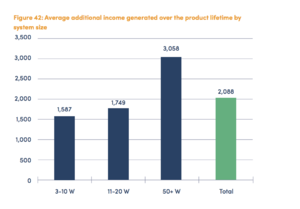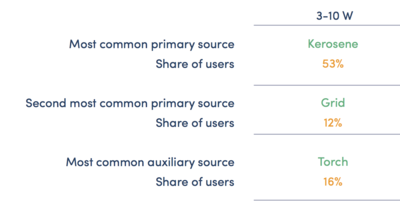Productive End Use of PicoPV
Overview
Productive End Use (PEU) of energy refers to activities that increase income or productivity in different sectors such as agriculture (e.g. irrigation, grain milling), manufacturing (e.g. carpentry, welding, and sewing), and the service sector (e.g. restaurants using electric lights, sound systems, refrigerators, mobile charging stations).[1]
PicoPV systems are basically small systems with a power output of 1-10W, mainly used for lighting and running small appliances such as charging mobile phones, playing radio etc. Within the SE4All multi-tier system, the picoPV systems fall under Tier 1 and are regarded as the first step on the energy ladder. The Sustainable Energy for All Global Tracking Framework has also acknowledge the technology as “transitional alternative to grid-based electricity”.[2][3]Therefore, picoPV systems are the most affordable and easily deployable systems for providing energy access to the rural customers.
Most of the studies on picoPV have so far focused only on the lighting aspect as it is the primary demand of the rural consumers. In a recent survey by GOGLA in 2018, 70% voted lightining as the main factor for buying the picoPV kit.[4]However, the rural consumers want more than basic lighting and picoPV products can cater to this need by providing additional services such as mobile phone charging and running small entertainment devices like radios and television.[5] This point was already noted in a GIZ study in 2010 but since then no study has been conducted to further assess the productive use of picoPV. Also the existing studies on productive use have mainly focused on Solar Home Systems (SHS) or solar based mini-grids as these systems have a higher capacity to power appliances as compared to picoPV.[6]
PicoPV are an affordable and easily deployable solution (although of small capacity) for providing energy access to the rural population.Combining energy access with productive use could help to boost the intake of the picoPV products as well as promote economic activity in the targeted area. According to this study, 28% of the interviewed customers used the picoPV for business or income generating activities. They also generated on average USD 1587 income. [4]
Hence, this article looks into the different uses of picoPV and the challenges for using picoPV for productive activities.[7]
Direct Productive Use of PicoPV: Mobile Charging
Mobile charging in rural areas is quite expensive and time costly.For example in Kenya, Malawi, Tanzania, Uganda and Zambia, the people pay up to USD 0.66 per week for mobile charging and have to walk almost 28 minutes one way to reach the next charging stations.[8]
Initially, picoPV products were designed to provide only basic lighting but with the emergence of new technology, the picoPV systems can now charge small appliances such as mobile phones. The mobile charger is either connected to the main lamp through a cable for charging from the battery or directly to the solar module.[6] According to this study from GOGLA, mobile phone charging was cited as the second most common driver for buying the picopv kit (53%).[4]
Mobile phone charging in rural areas can be a potential source of additional income. According to a survey conducted by GIZ in 2011 in Uganda, 70% of the surveyed household used mobile phone charging as an alternative income source. These households collected a fee of around 500 USH (0.14 USD) for charging other people’s phones. Assuming a household charges 7 phones per week (assuming a picoPV kit can charge a phone for 3 hours per day), the household generates an income of 3500 USH (0.97 USD) per week either by charging other’s phones or in the form of savings by not paying others for mobile phone charging. In Kenya, charging a mobile phone cost on average KES 60 (USD 0.7). Assuming a person provides mobile phone charging services for KES 20 per charge (reduced rate) and charges three phones per day, he/she will make KES 60 extra per day.[9]
Considering that charging a mobile phone cuts down on the light output, it can be seen as an alternative service rather than an additional service provided by these systems.[10] Hence households offering mobile charging services might not be able to use their picoPV kit for lightning purposes. Also, the PV kit has to be technically compatible with the mobile phone used in that particular country.
For more information, see: PicoPV for mobile charging.
Indirect Productive Uses of PicoPV
PicoPV products themselves might not directly result in many productive activities as they have a small capacity to run appliances but they might indirectly help to promote productive end use activities.
Longer Working Hours
PicoPV increases the time for income generation activities by task shifting i.e with more productive hours in the day, people can choose to do different tasks at different times. Better quality light is available for longer time at night which enable the businesses to run longer, resulting in higher income. For example, food stalls can run at night and increase their sale.
Also, the people can also increase their productive hours by spending less time on travelling to purchase kerosene, batteries or to charge their phone and having a phone which is charged more often.[4]
According to a recent survey from Solar Aid (2015), 98% of pico-solar light users reported positives effect of pico-solar lights on their business and also on how their customers interacted with their business.[11][12] This report from GOGLA includes survey results from among 2,300 new off-grid solar users in Kenya, Mozambique, Rwanda, Tanzania and Uganda. It shows for 51% households, at least one member was able to spend more time at work.[4]
An average kerosene light has a illuminance output of 20 while a picoPV kit ranges from 110, therefore resulting in brighter light. A picoPV kit replaces on average 1.6 kerosene lamps. This results in safer work place and also reduces the indoor air pollution cauesed by kerosene lamps.[4]
Switch from Kerosene and candles
According to this GOGLA study, kerosene is the primary source of fuel before purchasing picoPV kit.[4] By using picoPV products, people save on expenses on kerosene and candles. Assuming that a picoPV product has a three year life cycle, a household can save up to 86% of their previous energy expenses for kerosene and mobile charging. The saved amount can then be invested in activities that will help to generate additional income. The government will also save the money that they spend on kerosene subsidies and those savings can be used for other productive activities.[13]
Other Uses
- Pico PV helps to power recreational devices such as TV and radio, which helps to attract customers and increase the sale of products.
- PicoPV lights allows the children to study at night and better education has been demonstrated to increase income levels (higher productivity).[12]
- The money saved by using picoPV can be invested in other activities like household equipment, children's eduction, farm equipment etc.
Challenges for Productive Use of PicoPV
- The picoPV systems have a small capacity to run appliances which limits its performance.
- Using the picoPV system for productive use reduces the lighting duration which is the primary reason for buying the PicoPV system.
- The market is flooded with generic bad quality products. This has reduced people’s trust on the picoPV products and thus stringent lab and field test are required to set a benchmark for the products.
Conclusion/Recommendations for Further Research
Although picoPV systems are mostly used for lighting purposes, they do help to run services like mobile phone charging and also indirectly boost other productive activities. These picoPV systems are mostly bought by rural consumers for their household uses. Once their household needs such as lighting are met, they could potentially offer services like mobile phone charging to their community, resulting in higher productivity. With the emergence of new technologies, new electrical appliances such as television and refrigerator are now running on low capacity. This opens new possibilities for picoPV to power more appliances in future and aid in other productive use activities. Also, good experiences from picoPV systems encourage customers to invest in bigger SHS systems which ultimately could boost productive activities.
As there are not many studies conducted on productive uses of picoPV, it might be worthwhile to explore this area as picoPV systems are cheaper, affordable and easily deployable as compared to SHS. To start off with, it is important to conduct more surveys among the picoPV customers to assess for what purposes they use the system and if they are willing to or have already used the system for monetary gains. The results can then be assessed to see if and what kind of demands does the rural population have and if those demands can be met with picoPV systems.
Further Information
- PicoPV for Mobile Charging
- All articles on picoPV on energypedia
- Jobs Potentially Destroyed Due to Access to Modern Energy Services
Reference
- ↑ “Mini-Grid Webinar Series - Energypedia.info,” accessed July 7, 2017, https://energypedia.info/wiki/Mini-grid_Webinar_Series#3rd_Webinar:_Productive_End_Use.
- ↑ Michael Grimm et al., “A First Step Up the Energy Ladder? Low Cost Solar Kits and Household’s Welfare in Rural Rwanda,”(RWI, 2), accessed July 31, 2017, http://www.sun-connect-news.org/fileadmin/DATEIEN/Dateien/New/Low_cost_solar_kits_in_Rwanda.pdf.
- ↑ Michael Grimm, Peters Jörg, and Maximiliane Sievert, “Impacts of Pico-PV Systems Usage Using a Randomized Controlled Trial and Qualitative Methods,” (RWI, 2013), 2, https://english.iob-evaluatie.nl/binaries/iob-evaluatie-eng/documents/publications/2014/08/01/396---impacts-of-pico-pv-systems-usage/396-impacts-of-pico-pv-systems-usage.pdf.
- ↑ 4.0 4.1 4.2 4.3 4.4 4.5 4.6 Powering Opportunity: The Economic Impact of Off-Grid Solar | GOGLA.” [Online]. Available: https://www.gogla.org/powering-opportunity-the-economic-impact-of-off-grid-solar. [Accessed: 09-Oct-2018].
- ↑ Michael Grimm, Peters Jörg, and Maximiliane Sievert, “Impacts of Pico-PV Systems Usage Using a Randomized Controlled Trial and Qualitative Methods” (RWI, 2013), 1, https://english.iob-evaluatie.nl/binaries/iob-evaluatie-eng/documents/publications/2014/08/01/396---impacts-of-pico-pv-systems-usage/396-impacts-of-pico-pv-systems-usage.pdf.
- ↑ 6.0 6.1 GIZ, “What Difference Can a PicoPV System Make? Early Findings on Small Photovoltaic Systems - an Emerging Lowcost Energy Technology for Developing Countries,” 2010, 15, https://energypedia.info/images/3/3b/Gtz_picopv_booklet.pdf.
- ↑ “Features of PicoPV Systems - Energypedia.info,” accessed July 7, 2017, https://energypedia.info/wiki/Features_of_PicoPV_Systems.
- ↑ Kat Harrison, Andrew Scott, and Ryan Hogarth, “Accelerating Access to Electricity in Africa with off-Grid Solar - The Impact of Solar Household Solutions,” 18, accessed July 31, 2017, https://www.odi.org/sites/odi.org.uk/files/odi-assets/publications-opinion-files/10229.pdf.
- ↑ “ToughStuff East Africa: Affordable Quality Solar Alternatives for Low Income Consumers in Kenya,” 17, accessed August 1, 2017, http://bit.ly/2weIJLi
- ↑ “Solar Lamps Field Test Uganda - Final Report,” 53, accessed August 1, 2017, https://energypedia.info/images/7/72/GIZ_Solar_Lamps_field_Report_Uganda_Webversion.pdf.
- ↑ GIZ, “What Difference Can a PicoPV System Make? Early Findings on Small Photovoltaic Systems - an Emerging Lowcost Energy Technology for Developing Countries,” 6.
- ↑ 12.0 12.1 Kat Harrison, Andrew Scott, and Ryan Hogarth, “Accelerating Access to Electricity in Africa with off-Grid Solar - The Impact of Solar Household Solutions,” 11, accessed July 31, 2017, https://www.odi.org/sites/odi.org.uk/files/odi-assets/publications-opinion-files/10229.pdf. Cite error: Invalid
<ref>tag; name "Kat Harrison, Andrew Scott, and Ryan Hogarth, “Accelerating Access to Electricity in Africa with off-Grid Solar - The Impact of Solar Household Solutions,” 11, accessed July 31, 2017, https://www.odi.org/sites/odi.org.uk/files/odi-assets/publications-opinion-files/10229.pdf." defined multiple times with different content - ↑ ↑ UNEP/GEF, United Nations Environment Programme and Global Environment Facility, “Developing Effective Off-Grid Lighting Policy,” 2015, http://www.enlighten-initiative.org/portals/0/documents/Resources/publications/Guidance%20note%20OGL_en.lighten_English_2016-01-08.pdf.





















